The International Poultry Scientific Forum is held in conjunction with the International Poultry Expo each year and is sponsored by the Southern Poultry Science Society, the Southern Conference on Avian Diseases, and the U.S. Poultry & Egg Association. As part of that event, Novus International hosts a luncheon and speaker for the attendees on a topic of general interest to the poultry science community.
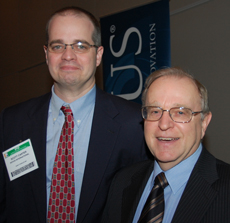 This year, it was “Historical Perspectives in Poultry Feed Management,” presented by well-known poultry science expert Dr. Steve Leeson from the University of Guelph, pictured here on the right with Dr. Scott Carter, Novus Poultry Market Manager, on the left. Dr. Leeson entertained the group with some great historical photos of poultry management through the years. According to Leeson, the commercial poultry industry as we know it pretty much started in the ’60s, as the broiler industry developed and the egg and meat industries began to diverge. Talking about feed management, he noted that producers early on were feeding poultry diets consisting of corn, soybean meal, milk, fish meal, meat meal and some raw vegetables. “They were looking for the vitamins that really hadn’t been recognized and we couldn’t buy them artificially,” he said. Milk was an especially important part of the diet to deal with health issues in flocks.
This year, it was “Historical Perspectives in Poultry Feed Management,” presented by well-known poultry science expert Dr. Steve Leeson from the University of Guelph, pictured here on the right with Dr. Scott Carter, Novus Poultry Market Manager, on the left. Dr. Leeson entertained the group with some great historical photos of poultry management through the years. According to Leeson, the commercial poultry industry as we know it pretty much started in the ’60s, as the broiler industry developed and the egg and meat industries began to diverge. Talking about feed management, he noted that producers early on were feeding poultry diets consisting of corn, soybean meal, milk, fish meal, meat meal and some raw vegetables. “They were looking for the vitamins that really hadn’t been recognized and we couldn’t buy them artificially,” he said. Milk was an especially important part of the diet to deal with health issues in flocks.
As poultry science began to develop as a specialty field, researchers found that key nutrition requirements could be met in other ways, which helped the industry expand and become much more productive and efficient.
Download (mp3) my interview with Dr. Leeson or listen to it here: ipe10-novus-leeson.mp3
Scott says Novus chose a historical perspective for this year’s topic as a way of taking a look back in order to move forward. “We’re at a really critical junction right now as we’re going to need to produce twice as much food in 2050 as we do today,” Scott said. “Poultry is going to be a key part of helping to feed the world by 2050.” Increasing productivity and efficiency even more will play an important role in meeting that goal.
Novus is also celebrating two significant anniversaries this year of products that have been part of the historical progress in poultry feed management. “It’s our 30th year for Alimet and our 50th year for Santoquin in the marketplace as nutritional tools that have helped us improve performance,” said Scott.
Download (mp3) my interview with Dr. Scott Carter or listen to it here: ipe10-novus-carter.mp3
2010 International Poultry Expo photo album
AgWired coverage of International Poultry Expo is sponsored by:

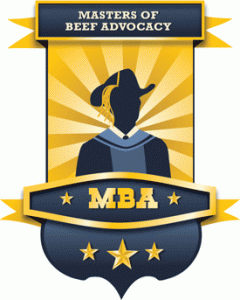 Yesterday, I had the opportunity to take part in the Checkoff’s Masters of Beef Advocacy (MBA) Commencement Ceremony, where I was the afternoon speaker. My speech was titled, “Discovering the Power of Social Media,” and I challenged the graduates to use these online tools to share the agriculture story.
Yesterday, I had the opportunity to take part in the Checkoff’s Masters of Beef Advocacy (MBA) Commencement Ceremony, where I was the afternoon speaker. My speech was titled, “Discovering the Power of Social Media,” and I challenged the graduates to use these online tools to share the agriculture story. 


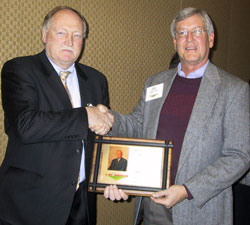
 When it comes to chelated trace minerals, Dr. Jim Richards with
When it comes to chelated trace minerals, Dr. Jim Richards with 
 This year, it was “Historical Perspectives in Poultry Feed Management,” presented by well-known poultry science expert Dr. Steve Leeson from the University of Guelph, pictured here on the right with Dr. Scott Carter, Novus Poultry Market Manager, on the left. Dr. Leeson entertained the group with some great historical photos of poultry management through the years. According to Leeson, the commercial poultry industry as we know it pretty much started in the ’60s, as the broiler industry developed and the egg and meat industries began to diverge. Talking about feed management, he noted that producers early on were feeding poultry diets consisting of corn, soybean meal, milk, fish meal, meat meal and some raw vegetables. “They were looking for the vitamins that really hadn’t been recognized and we couldn’t buy them artificially,” he said. Milk was an especially important part of the diet to deal with health issues in flocks.
This year, it was “Historical Perspectives in Poultry Feed Management,” presented by well-known poultry science expert Dr. Steve Leeson from the University of Guelph, pictured here on the right with Dr. Scott Carter, Novus Poultry Market Manager, on the left. Dr. Leeson entertained the group with some great historical photos of poultry management through the years. According to Leeson, the commercial poultry industry as we know it pretty much started in the ’60s, as the broiler industry developed and the egg and meat industries began to diverge. Talking about feed management, he noted that producers early on were feeding poultry diets consisting of corn, soybean meal, milk, fish meal, meat meal and some raw vegetables. “They were looking for the vitamins that really hadn’t been recognized and we couldn’t buy them artificially,” he said. Milk was an especially important part of the diet to deal with health issues in flocks. 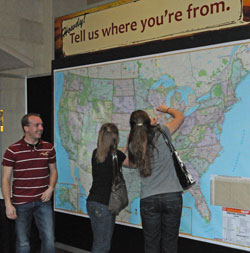 This is an interesting display in the entrance hallway to the Cattle Industry Convention.
This is an interesting display in the entrance hallway to the Cattle Industry Convention.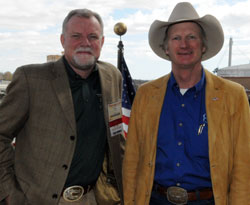 The combined meetings of the
The combined meetings of the  The 2010 International Poultry Expo/Feed Expo is getting underway here in Atlanta with associated conferences today, including the Poultry Scientific Forum, Pet Food Conference and Animal Agriculture Environmental Sustainability Summit.
The 2010 International Poultry Expo/Feed Expo is getting underway here in Atlanta with associated conferences today, including the Poultry Scientific Forum, Pet Food Conference and Animal Agriculture Environmental Sustainability Summit. 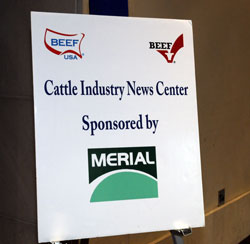 Thanks go to
Thanks go to